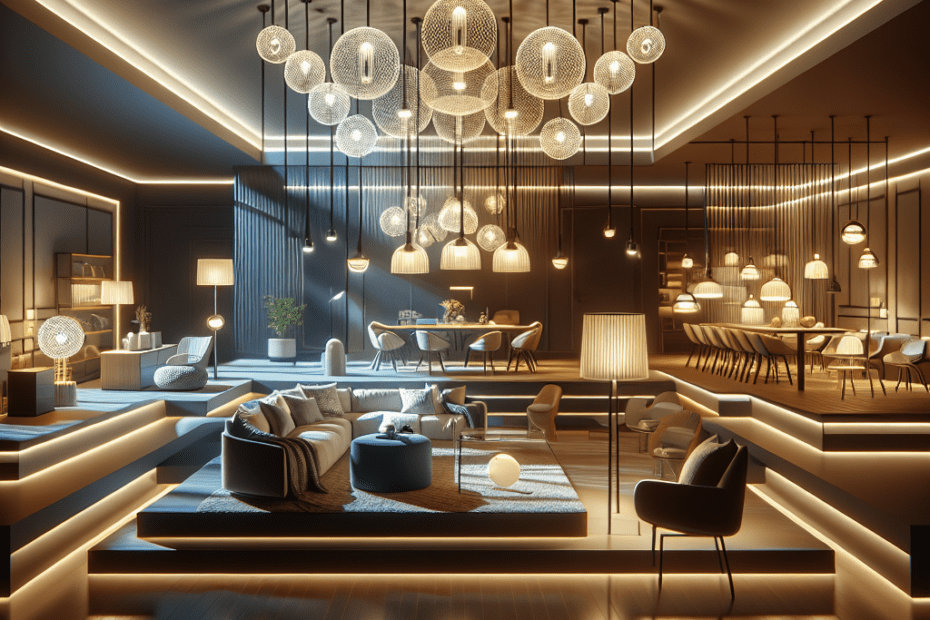“`html
The Power of Layered Lighting in Modern Interiors
Layered lighting in design has not only become a popular trend but an essential tool in shaping modern interiors. Designers and homeowners alike are turning to this technique to add depth, interest, and functionality to their spaces. Layered lighting involves using multiple light sources at different levels to create a balanced and harmonious atmosphere. This concept includes ambient, task, and accent lighting, each serving a unique purpose to enhance the overall design.
Understanding the Layers
They are focusing on how layered lighting impacts interior design. Let’s break down the three main components:
- Ambient Lighting: The base layer that provides overall illumination to a space. This can come from ceiling fixtures, wall sconces, or even natural light sources.
- Task Lighting: Focused lighting that aids in specific activities like reading, cooking, or working. Adjustable lamps and under-cabinet lighting are common examples.
- Accent Lighting: These fixtures highlight certain architectural features or decorative elements. Think spotlights, track lighting, or outdoor uplighting.
Each of these layers plays a vital role in creating a functional and visually appealing interior environment.
The Importance of Layered Lighting in Design
Experts highlight that layered lighting in design has the ability to transform a space on multiple levels:
- Improving functionality by providing appropriate lighting for various activities.
- Enhancing mood and ambiance, making spaces feel warm, inviting, or even dramatic.
- Emphasizing architectural and design features, allowing them to stand out.
According to the American Lighting Association, 91% of designers believe that layered lighting is integral to interior design. This statistic from their 2022 survey shows how widely accepted this approach is.
Layered Lighting’s Role in Modern Designs
In modern interior design, functionality and aesthetic appeal go hand in hand. Layered lighting ensures that these elements are balanced effectively. For instance, in open-concept spaces, distinct lighting zones are established to delineate between different functional areas without needing walls. In kitchen designs, layered lighting adds both style and practicality by combining ambient ceiling lights, task lighting over countertops, and accent lights in glass cabinets.
By using dimmers, layers can be adjusted to suit different times of day or activities, allowing for flexibility and energy efficiency. Statistics from Energy Star (2023) show that homes with well-planned lighting can reduce energy usage by up to 30% compared to traditional lighting setups.
Practical Applications of Layered Lighting
Their use of layered lighting in various rooms demonstrates its versatility. Here’s how it can be effectively applied in different areas of a home:
| Room | Layered Lighting Example |
|---|---|
| Living Room | Combine ceiling fixtures (ambient), reading lamps (task), and picture lights (accent) to create a cozy and dynamic environment. |
| Kitchen | Use pendant lights over islands (task), recessed ceiling lights (ambient), and strip lighting under cabinets (accent). |
| Bedroom | Integrate a chandelier or ceiling light (ambient), nightstand lamps (task), and LED strips behind bed frames (accent). |
These applications illustrate the adaptability and enhanced aesthetics that layered lighting brings to different settings.
Key Takeaways
- Layered lighting involves a combination of ambient, task, and accent lighting.
- It improves the functionality and mood of interior spaces while highlighting design features.
- 91% of designers agree on its importance in modern interior design.
- Responsible application of layered lighting can yield energy savings of up to 30%.
Frequently Asked Questions (FAQ)
- What is layered lighting?
Layered lighting combines different types of lighting—ambient, task, and accent—to create a balanced interior environment. - Why is layered lighting important in design?
It enhances functionality, mood, and highlights specific architectural or design elements in a space. - How can layered lighting save energy?
By using dimmers and strategically placed lighting, energy consumption is optimized, potentially reducing usage by up to 30%. - What is an example of task lighting?
Task lighting includes reading lamps or under-cabinet lights that focus on specific areas for activities like reading or cooking. - Can layered lighting work in small spaces?
Yes, even in small spaces, carefully selected layered lighting can create depth and enhance the overall appeal.
Layered lighting in design stands as a testament to the combination of art and functionality, breathing life into spaces and making them adaptable to human needs and emotions.
“`
